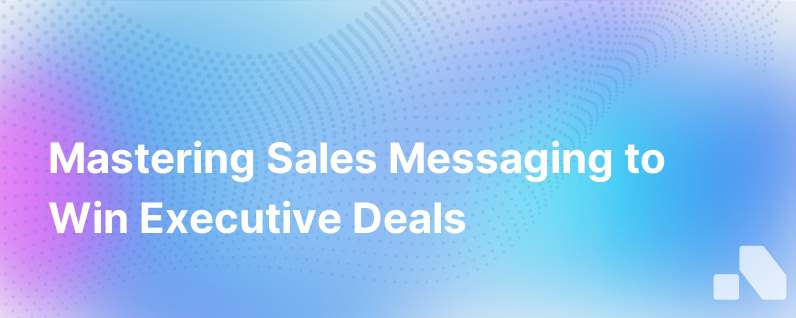Sales Messaging
Published on September 21, 2023 by Sawyer Middeleer
In a crowded and competitively fierce B2B market, your sales messaging can mean the difference between a deal won or lost. As a startup with ambitious growth targets, getting your sales messaging right is pivotal. However, with prospects inundated with hundreds of sales pitches daily, breaking through the noise is a real challenge.
Sales messaging isn't just about promoting your product or service but about scripting a narrative that resonates deeply with your prospects' needs, pains, and aspirations. It’s the crafting of a compelling story that connects on a human level and demonstrates clear understanding and value. It’s not merely saying what you sell but framing it in the context of what it solves.
In this guide, we’ll take an intricate look at the nuances and strategies behind persuasive and effective sales messaging, which can be your lever to unlock a sales conversation and steer it towards a sealed deal.
Understanding Sales Messaging
Sales messaging is the strategic articulation of your value proposition, tailored to the specific needs, challenges, and outcomes that matter to your potential customers. Rather than listing features and functions, it hones in on the benefits and business outcomes of your offering, honing in on what will move the needle for the prospect's business.
Effective sales messaging:
- Captures attention quickly using a strong value-based proposition.
- Is relatable and speaks directly to the prospect’s business pain points.
- Tells a compelling story that connects the dots between customer needs and your solution.
- Differentiates boldly from competitors.
Crafting a Sales Message
The most successful sales messaging strategies incorporate the following tried-and-tested principles:
Know Your Audience: Research your target prospect to understand their industry, business model, competitive landscape, pain points, and decision-making process. This understanding forms the foundation of message relevance.
Refine Your Value Proposition: Clarify your offering's unique value. Consider what makes your product or service stand out in terms of features, benefits, returns on investment, and customer experiences.
Prioritize Clarity and Brevity: Your message should be clear and concise, avoiding jargon and technical complexities that cloud comprehension. Capture interest quickly, ideally within the first few sentences.
Lead with Benefits, Not Features: Focus on how your offering improves the prospect's business, not on the specifications of the product or service. Feature-driven messaging risks sounding like a commodity, while a benefits-driven approach positions you as a solution provider.
Craft a Persuasive Narrative: Humans are wired for storytelling. Frame your messaging within a narrative that illustrates rather than tells, situating your prospect as the hero with your solution as their trusted ally.
Evidence-Based Assertions: Whenever possible, back up your claims with data, case studies, testimonials, or endorsements. Credible evidence lends weight to your value proposition.
Be Flexible and Adaptive: No single sales message fits all prospects. Be prepared to pivot and adjust your messaging based on the unique challenges and interests of each potential customer.
Continual Iteration and Feedback: A sales message is never truly "final." Iteration is key, using feedback from prospects, market changes, and sales data to continually refine your approach.
Sales Messaging Techniques
Here are techniques and components vital to constructing your sales messaging:
Establishing a Connection: Start by acknowledging your prospect’s current situation or challenge. Empathy here can quickly build rapport and show that you understand their context.
Articulating the Challenge: Clearly define the hurdles preventing your prospect from achieving their goals, which your product or service can help overcome.
Presenting the Solution: Offer a brief overview of how your offering provides the answer to the defined challenge. Use simple language and vivid imagery when possible.
Sharing Success Stories: Use case studies or testimonials to demonstrate real-world proof of your solution's impact. This not only adds credibility but also allows prospects to visualize the potential outcomes for themselves.
The Call-to-Action: End with a clear and compelling call-to-action (CTA). Whether scheduling a demo, downloading a whitepaper, or simply participating in a follow-up call, make the next steps easy and enticing for the prospect to engage further.
Avoid Common Pitfalls
There are common pitfalls to be aware of:
Over-Complexity: Don’t let important messages get lost in detail. Keep it simple.
Feature Frenzy: Lists of features can overwhelm and confuse. Focus on outcomes and benefits.
Assumption of Knowledge: Never assume the prospect has prior knowledge of your product or market jargon.
Missing the 'Why': It's not enough to present a capability. Prospects need to understand why it matters to them.
Static Messaging: Sales messaging should evolve as your product, and the markets do. Stay current and compelling.
Conclusion
Your sales messaging is a key determinant in the success of your startup’s outreach efforts. It aligns your sales team, informs content creation, guides campaign strategies, and sets the tone for customer relationships. Focusing on crafting a message that spotlights customer benefits and outcomes, supported by evidence and told through a relatable narrative, will increase the effectiveness of your outreach.
Thoughtful and methodically crafted sales messaging can transform lukewarm prospects into engaged dialogue partners, and ultimately, into satisfied customers. Moreover, as your startup grows and the market shifts, regularly revisiting and refining your sales messaging ensures it remains resonant and effective, keeping your value proposition sharp in the eyes of your prospects.
Consider not only the immediate impact of your words but the enduring story they tell about your brand. Sales messaging is more than a tool; it’s an ongoing dialogue—one that begins with the first call and continues throughout the buyer's journey, fostering a reputation for value, relevance, and responsiveness.